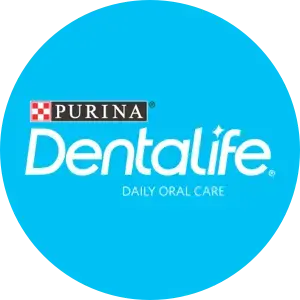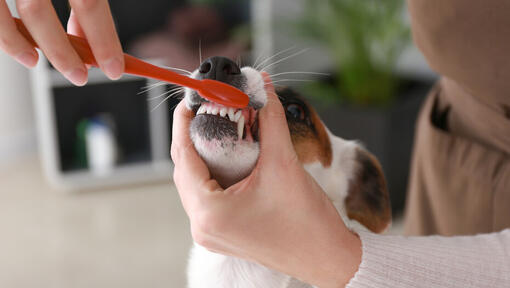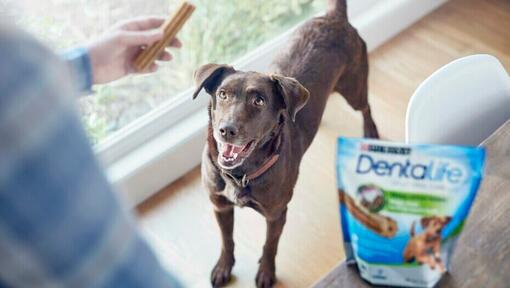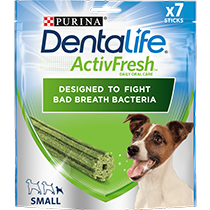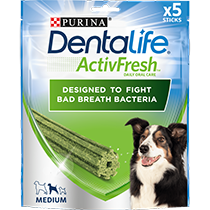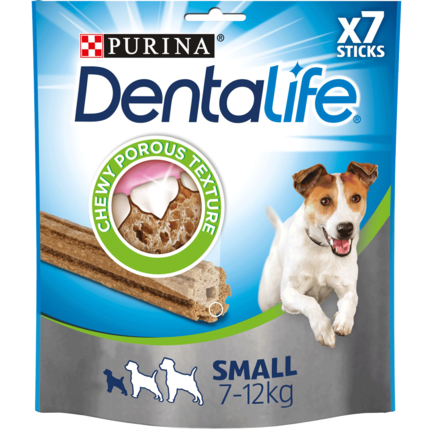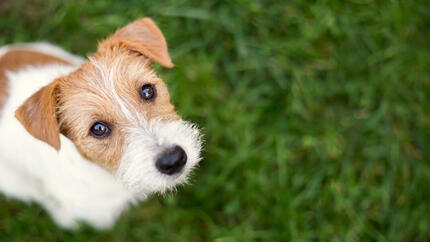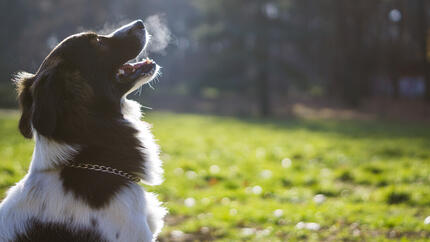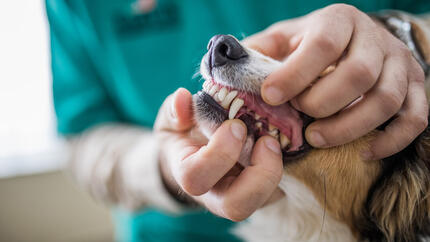

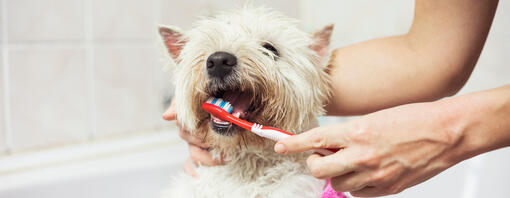
Did you know that dental problems are one of the most commonly diagnosed health condition in all dogs over the age of three thought to affect 80% of dogs in this age group a greater or less degree? Because your dog's teeth and gums are as vulnerable to disease as yours, make sure you give the same care and attention to your dog's dental health as you do to your own.
Dental disease in dogs
When your four-legged friend has healthy teeth and gums they can get the most out of their food, crunching every delicious kibble with ease, but if their teeth or gums hurt, they’ll soon go off their meals and their quality of life can suffer – along with their metabolism.
Poor dental care doesn’t just affect their mouths; the bacteria generated by dental disease could eventually enter your dog’s bloodstream and potentially damage their heart, liver or kidneys. So, as a loving owner, what do you need to look out for to protect your dog’s pearly whites?
Plaque
Bacteria constantly form in your dog’s mouth and when they mix with with saliva and leftover morsels of food, your dog will get a sticky and colourless film (plaque) collecting on the outside of their teeth, especially their upper pre-molars and molars. It’s important to clean this plaque off dog’s teeth as if it’s left to build up, it can harden to form tartar.
Periodontal Disease
After 3-5 days of being left untouched, plaque forms another alliance, this time with the minerals in your dog’s saliva. This hardens the plaque and it turns it into tartar, also known as calculus. Tartar can irritate your dog’s gums causing gingivitis, a swelling and reddening of the gums, and can lead to bad breath - something you’re likely to notice quite quickly! Dry dog foods can help scrape away plaque and tartar but you’ll still need to supplement this with some dog dental care.
After 3-5 days of being left untouched, plaque forms another alliance, this time with the minerals in your dog’s saliva. This hardens the plaque which is what it turns it into tartar, also known as calculus. Tartar can irritate your dog’s gums causing gum disease. Dry dog foods can help scrape away plaque and tartar but you’ll still need to supplement this with some dog dental care.
What are the most common dog dental problems?
Oral disease
You should examine your dog's mouth regularly for signs of oral disease. Your first hint is likely to be bad breath (which is hard to ignore) but also look out for reddened, bleeding or swollen gums, crusted yellow-brown tartar build-up on the teeth and in more advanced cases, drooling.
If your dog develops severe gingivitis you might also notice them dropping food when they eat, eating on one side of their mouth, or not eating at all, which can all lead to weight loss. This is why it is so important to keep an eye on your dog’s teeth as part of your regular grooming care and not giving dental issues the chance to progress. While you’re giving their mouth a good once over, always look for fractured, discoloured or missing teeth and lumps and bumps on their gum line and make sure their jaw itself isn’t swollen or misshapen.
Trauma to the teeth
Of course not all canine dental problems are caused by disease – your dog’s teeth could get broken or fractured by vigorous chewing on very hard objects or simply by an accidental injury when they’re playing. Whenever you examine your dog’s mouth, check for broken or worn teeth and encourage your pet to chew on dog chews and toys and never stones or sticks.
How to clean dogs’ teeth
Cleaning dogs' teeth is important, as it can prevent the build up of plaque and tartar. If left untouched for 3-5 days, plaque combines with minerals in your dog’s saliva to harden and turn to tartar. Tartar can irritate your dog’s gums and provide a rough surface to harbour more bacteria, causing gingivitis (a swelling and reddening of the gums) and can lead to bad breath – which you’ll probably notice! Keeping your dog’s teeth clean can help scrape away plaque.
Ideally you should aim to brush your dog’s teeth every day, as you do your own, but if that’s not possible, try to give your dog's teeth and gums some attention at least 3-4 times a week.
Taking care of your dog’s teeth should start from the very start of your life together. Dental care should begin while your puppy still has their deciduous puppy teeth (they’ll lose these at about 4-6 months old). If you can get your puppy used to you looking in their mouth and caring for their teeth when they’re young, it will make it so much easier later in life.
As part of introducing your puppy to being handled and trusting your hands, begin by getting them used to you running your hands or fingers down the side of their face. This is best done when your puppy is relaxed and sleepy so it doesn’t turn into a game of nibble/bite the hands!
When they are happy with this, you can gently run your finger under their lips along their gums. From here you can buy a rubber finger toothbrush (either with a brush on the end or just rubber nobbles) and use this instead of your bare finger.
If you are starting with an adult dog, the procedure is exactly the same. Always be sure they are happy with each step before moving on to the next one though – as they have adult teeth and you want to make very sure you don’t get chomped! Keep your fingers on the outside of the gums only.
Once your puppy or dog is happy having their gums rubbed, you can progress to a soft dog toothbrush (you can get these at your vet surgery). Don’t worry about toothpaste at first; it’s more important to get them used to the sensation of the brush.
Start by doing nothing more than just rubbing the toothbrush on their gums for a few seconds so they can get used to the sensation.
Once they are happy with the feel of the brush, you can start to think about some more intense dental care.
Soak the toothbrush in warm water and apply to the teeth with the brush head at a 45-degree angle, so you can focus on reaching under the gum line where their teeth and gums meet. Stroke up and down gently, in even movements, with only a little pressure.
When your dog is completely happy with their special dog toothbrush you can start to introduce enzymatic canine toothpaste. These are specially formulated for dogs, with flavours that include meat flavours that your dog is likely to enjoy – yum! Just as you wouldn’t want to use dog toothpaste, your dog should never use human toothpaste either. Human toothpaste is designed to be spat out – whereas dogs will eat theirs – and human toothpaste is often highly toxic for dogs.
You can’t expect your dog to suddenly accept you fiddling around in their mouths brandishing a toothbrush, particularly if tooth brushing has only began later in their lives, but don’t give up.
With patience and time you should be able to persuade them to have their teeth brushed but, in the meantime, there are a few other things you could try such as oral hygiene gels, available from your vet, that contain enzymes to inhibit the bacteria responsible for plaque, chew toys and specially formulated dental chew products designed to reduce tartar and massage the gums. Or even adding crunchy vegetables to their meal.
If your older dog isn’t too keen on having their teeth brushed, speak to your vet as they may be able to give you some helpful tips.
Dentalife dog dental chews
As a supplement to your dog’s dental routine, consider feeding them Dentalife dog dental chews, scientifically proven to help reduce tartar build-up when used daily, ensuring that their teeth and gums are kept in tip top condition.
Your dog's dental examination at the vet
As part of your regular health checks, your vet can also look at your dog’s teeth. At a regular dental check-up, your vet will look at several different areas to make sure your dog’s mouth is a healthy as it can be. This includes examining your dog’s face and head to look out for any asymmetry, swelling or discharges.
They will then look into their mouth and check the lining of their lips, the surfaces of their teeth and gums, the hard-to-reach inner surfaces of their teeth and gums as well as their tongue, palate, tonsils and the area underneath the tongue.
If your dog's teeth have tartar build up your vet may recommend that this is removed, and their teeth polished, under anaesthetic. This professional dental cleaning procedure (called a prophylaxis) might include:
- Flushing their mouth with an antibacterial solution.
- Cleaning their teeth with handheld and ultrasonic scalers to remove tartar from above and below the gum line.
- Using a disclosing solution to show any areas of remaining tartar – and then removing it.
- Polishing their teeth to remove microscopic scratches.
- Inspecting each tooth, and the gum around it, for any signs of disease.
- Extracting any teeth that are beyond repair.
- Once your dog’s teeth are spick and span your vet will then advise you how you can keep them that way. By cleaning your dog’s teeth at home you can take on the responsibility of their regular dental care, cut down on vet visits and help keep your dog’s teeth and breath squeaky clean!
If you have any concerns about your dog’s teeth however don’t wait until a regular vet visit!
A chew a day: Dentalife's dog chews designed for dental care
Dentalife dog dental chews can be a great addition to your dog's dental care routine. The chewy porous texture and ridged design has been specially created to ensure a thorough clean that reaches even their back teeth – which are most prone to developing tartar and plaque. These dog dental chews are scientifically proven to help reduce tartar build-up when used daily, ensuring that their teeth and gums are kept in tip top condition. Plus, they’re flavoured with tasty chicken, so your dog is bound to find them completely delicious.
Start your dog’s daily oral care routine with Dentalife dog dental chews – scientifically proven to reduce tartar build-up for healthier teeth and gums.
If you're looking for more dog hygiene and grooming tips, read our dog grooming guide, next.
Shop the Dentalife Dog range:
Related articles by Dentalife
